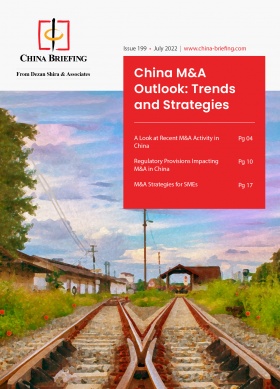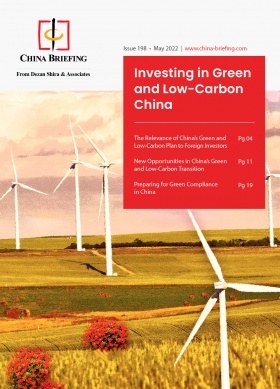Business Environment in South China: The Small Business Point of View
For many years, Dezan Shira & Associates has kept close contact with companies and entrepreneurs all over China, listened to their concerns and suggestions and bore witness to their failures and successes.
We have done so not only by paying close attention to the business surveys and position papers that chambers of commerce publish from time to time, but by also directly talking to our clients, asking them questions, listening to their worries, and when needed, devising possible solutions.
In this article, we look into the concerns of small businesses in South China and some recent signs that things will be better in the near future.
The current COVID-19 pandemic—biggest concern of South China businesses
Yes! We say current. Because even though the rest of the world seems to have moved on from it and going as far as declaring its “end”, as President Biden stated recently, and removing all the containment measures associated with it, as did the UK and most countries across the globe, it’s not the case here. In China, the containment measures associated with the pandemic remain alive, with some saying that said measures are even increasing in its occurrence, intensity, and unpredictability.
As the World Health Organization (WHO) Chief Tedros Adhanom Ghebreyesus stated, the pandemic was still not over despite the improvements —“We have spent two-and-a-half years in a long, dark tunnel, and we are just beginning to glimpse the light at the end of that tunnel…it is still a long way off, and the tunnel is still dark, with many obstacles that could trip us up if we don’t take care.” This stance may be one of the many reasons why China continues to maintain its borders closed to most types of visa, imposing quarantine upon entry (although recently reduced to 5 days at hotel plus 3 days at home), daily use of mask, 48 hour nucleic acid tests in most cities, and many other measures that vary across the region, city, and even neighborhood.
Most people and small businesses are still nostalgic for “the time before COVID” when you could cross the border from Shenzhen to Hong Kong for breakfast, go to Macao for lunch, and return to Shenzhen for dinner without a concern in your heart. These people keep hope and have the expectation that change is just around the corner and that at any point we will return to a status of “business as usual” with the charming chaos of full restaurants, cinemas, and hordes of tourists as far as the eye can see.
However, as they say, “expectations minus reality equals disappointment” and reality has proven to be very disappointing for a great number of people, who were hoping the COVID-19 measures would be relaxed and things could go back to normal after October.
“It’s the lack of predictability that gets me” – a sports school owner says, stating that for one week things can go smoothly, and group outdoor activities can occur normally, while the week after, the group gatherings are prohibited for three days at least even if there are no cases within the school—if someone has been in close contact with the confirmed cases.
“The rules are always changing. One day you are compliant, the next day you don’t know what to do.” These complaints are from another business owner, who does not understand the degrees of separation a person must have from close contacts, in order to not be put under lockdown, quarantined, etc.
Some extremely beloved local restaurants did not have the financial liquidity to withstand the February and March lockdowns (and the subsequent mini lockdowns). Others, however, are resilient and keep soldering on. “We are fighting the clock,” a restaurant group owner says, adding, “We are surviving on bare minimum customers, hoping that soon, soon things will change and if not, we close.”
Light at the end of the tunnel—recent COVID relaxations
Knowing full well that the economy is not what it could be, with youth unemployment on the rise and some bankruptcies here and there, China has increasingly emphasized that it will making more efforts to protect people’s life and health while minimize the social and economic fallouts.
Adding to this is the international pressure that the markets are putting on China to fully open—chambers of commerce in China, such as AmCham and European Chamber—have repeatedly expressed their concerns about the impact of China’s stringent COVID-19 rules on business confidence.
In addition, there are other factors that will require China to consider adjusting its COVID-19 policy, such as the enormous cost that these containment measures are having on the coffers of the Chinese government, including the cost to hire permanent medical personnel across the country, buy literal tons of supplies for tests, cleansing, and treatment, etc.
The government is moving slowly and cautiously, avoiding giving good news and false hope, but slowly and surely things are changing with an ease in issuance of business and work visas, reduction of the international quarantine.
For example, on November 11, 2022, the National Health Commission (NHC) released a circular that China will ease some of its COVID-19 rules to better balance COVID-19 prevention and control with economic and social development. Among others, the below adjustments have been introduced:
- For close contact and inbound travelers, the quarantine requirement will change from “7 days centralized quarantine + 3 days home health monitoring” to “5 days centralized quarantine + 3 days home quarantine”. Upon the completion of the quarantine at the first point of entry, the quarantine at the destination shall not be repeated for inbound travelers.
- The secondary close contacts will no longer be traced.
- For people passing through high-risk areas, the quarantine requirement will change from “7 days centralized quarantine” to “7 days home quarantine”.
- The three categories of “high-risk areas, medium-risk areas, low-risk areas” will be simplified to two categories—”high-risk areas and low-risk areas”.
- Areas that are not experiencing outbreaks are discouraged from mass testing.
- The circuit breaker mechanism for inbound flights will be abolished, and the requirement of “two negative nucleic acid tests within 48 hours before boarding” will be adjusted to “one negative nucleic acid test within 48 hours before boarding”.
- For important inbound business personnel and sports groups, etc., they shall be exempted from quarantine under a ” closed-loop bubble”, which means “point-to-point” transfer to the isolation free closed-loop management area.
- China shall intensify efforts to address the problem of “one-size-fits-all”. It is strictly prohibited to arbitrarily close schools and classes, suspend production, block traffic without approval, arbitrarily adopt “static management”, arbitrarily lock down, etc.
- During the COVID-19 outbreak, China shall make every effort to ensure smooth logistics. It is prohibited to arbitrarily ask key enterprises related to the overall industrial chain and affecting people’s livelihoods to suspend production.
Following the release of the NHC circular, many cities quickly followed up with detailed implementation measures to improve the local COVID-19 prevention and control procedures. For example, Guangzhou lifted lockdowns on secondary close contacts in the afternoon of November 11.
Renowned institutions, such as the International Monetary Fund (IMF), predicted that China will exit from zero COVID in 2023.
Conclusion
The GBA is undoubtedly China’s richest, most well-planned, and most technologically advanced region and its potential is limitless.
Attentive to these small steps, the entire local and international communities are together in “crossing fingers”, hoping that 2023 is year- Y, in which, even if we don’t go completely to a pre-pandemic time, we will have the stability, growth, and above all, hope that companies and entrepreneurs had and keep having for the south of China and for the country as a whole.
We will keep monitoring and keep you updated on any changes.
About Us
China Briefing is written and produced by Dezan Shira & Associates. The practice assists foreign investors into China and has done so since 1992 through offices in Beijing, Tianjin, Dalian, Qingdao, Shanghai, Hangzhou, Ningbo, Suzhou, Guangzhou, Dongguan, Zhongshan, Shenzhen, and Hong Kong. Please contact the firm for assistance in China at china@dezshira.com.
Dezan Shira & Associates has offices in Vietnam, Indonesia, Singapore, United States, Germany, Italy, India, and Russia, in addition to our trade research facilities along the Belt & Road Initiative. We also have partner firms assisting foreign investors in The Philippines, Malaysia, Thailand, Bangladesh.
- Previous Article No Change In US Partisanship Towards China After Mid-Term Election Results – But China Market Opportunities For US Investors Continue To Grow
- Next Article Belt And Road Weekly Investor Intelligence #107







